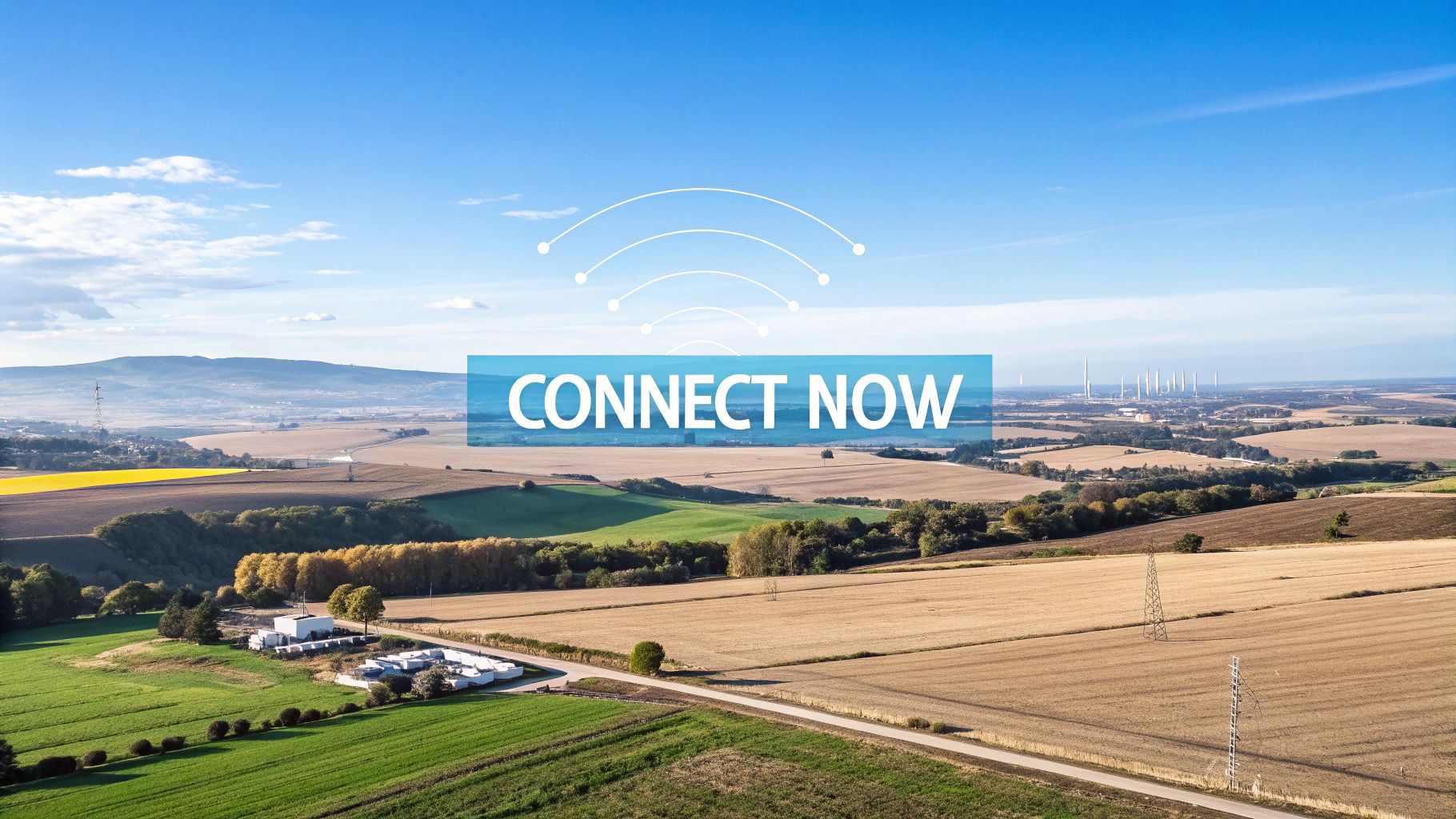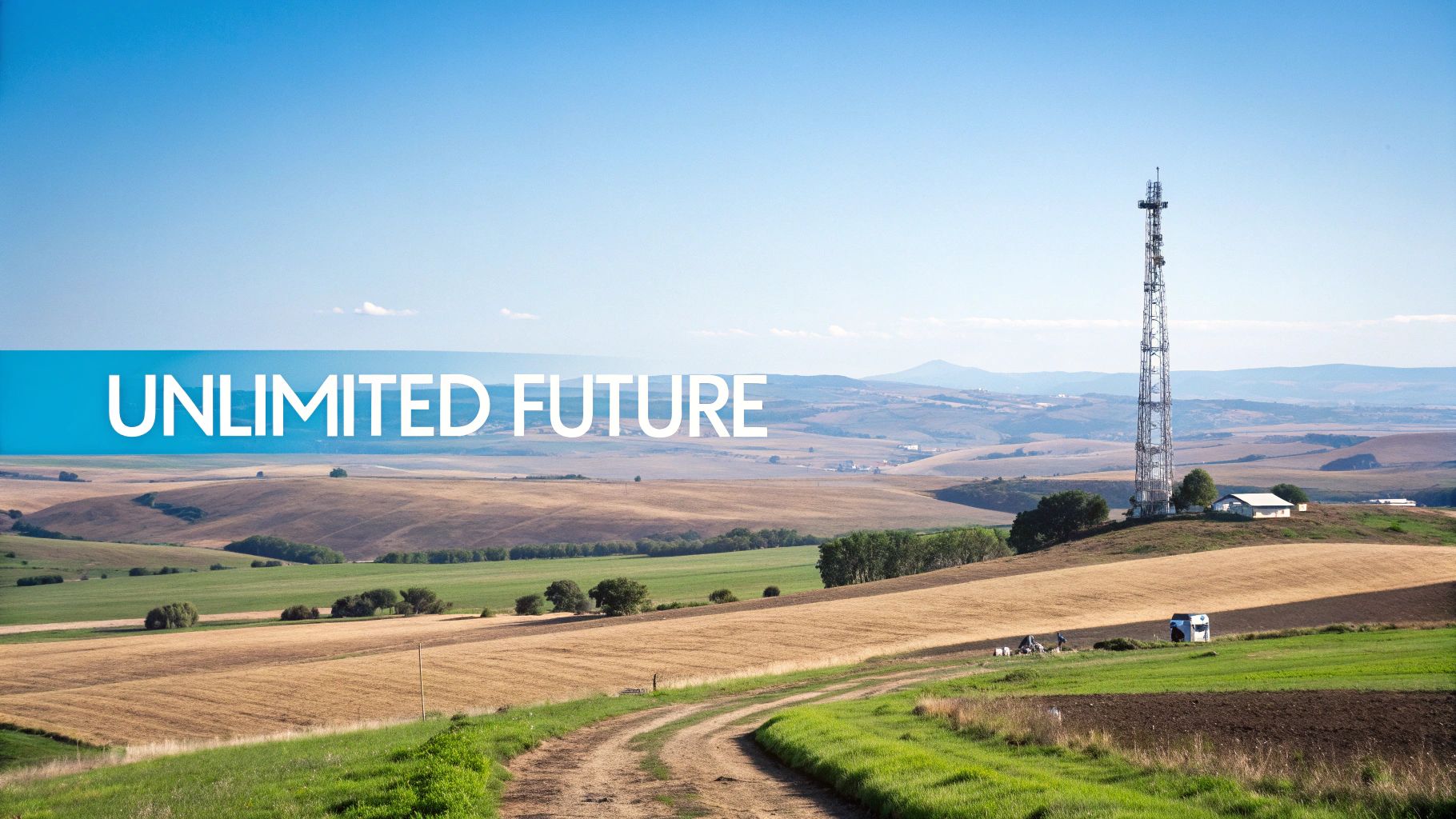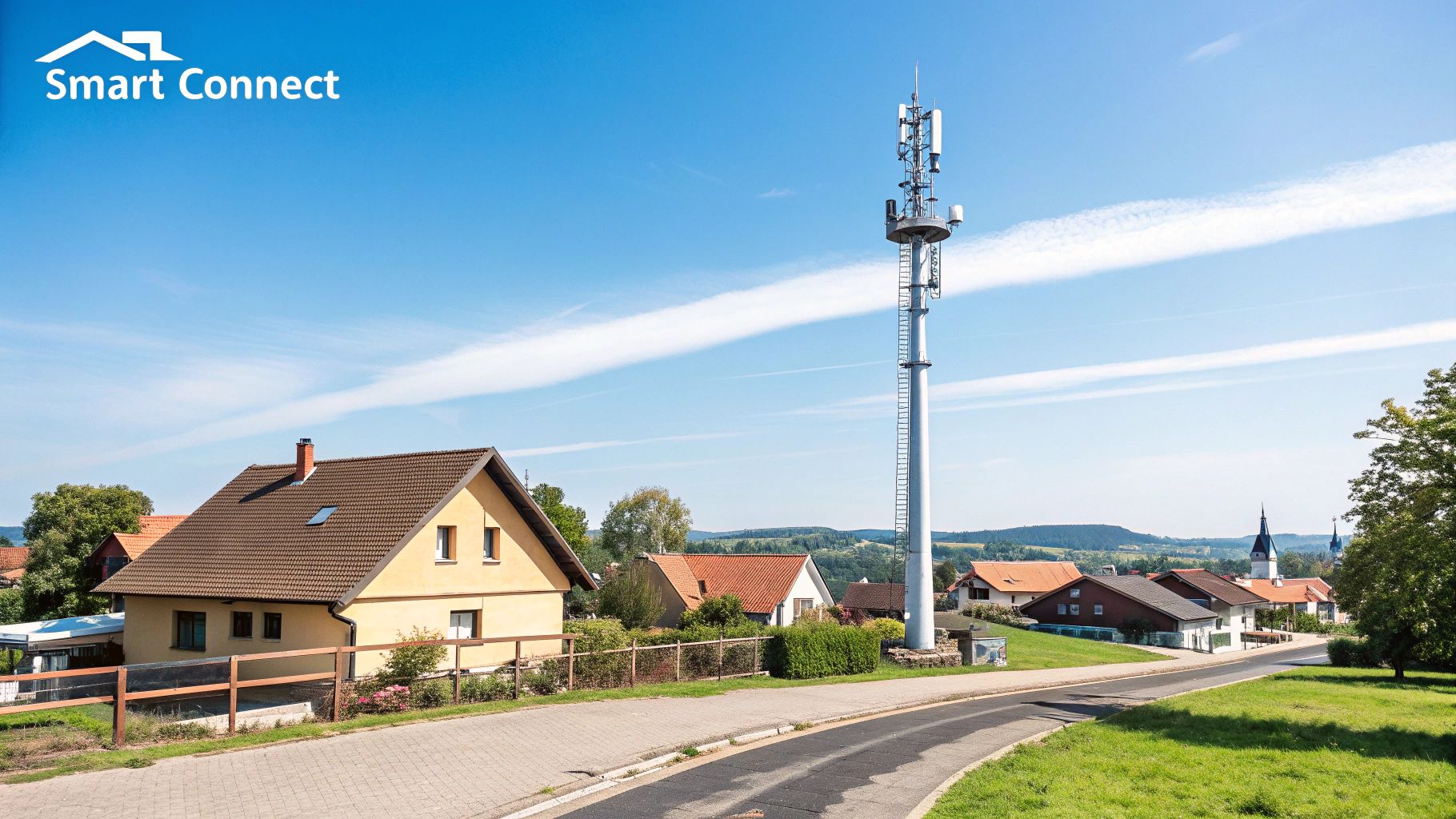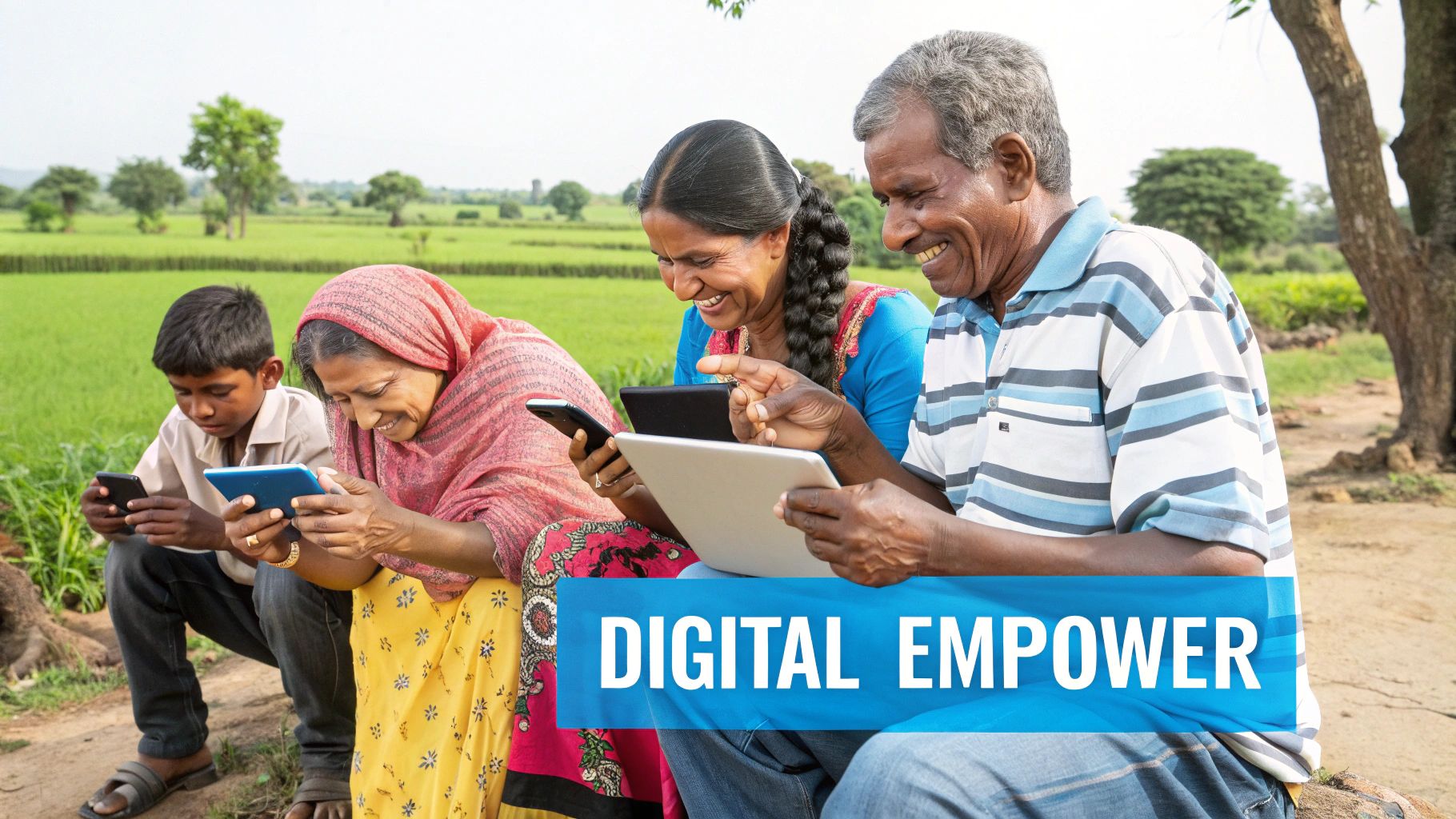

· Por James
Unlimited Internet in Rural Area: Connect Now
The Real State of Rural Internet Today

The digital divide significantly impacts millions living in rural areas. While urban areas enjoy easy access to the internet, many rural communities struggle with limited and unreliable internet service. This disparity creates substantial challenges, impacting economic development, access to education and healthcare, and the overall standard of living. This section examines the present condition of rural internet access, highlighting the key obstacles and the critical need for effective solutions.
The Urban-Rural Connectivity Gap
The difference between internet access in urban and rural areas is stark. Imagine a city with high-speed fiber optic internet readily available to homes and businesses. Now picture a rural area where slow DSL or inconsistent satellite internet is the only option. This isn't a minor inconvenience; it's a major roadblock.
This digital divide restricts access to opportunities like online education, telehealth services, and remote work, which can stifle economic growth and hinder upward mobility for rural residents. For example, a farmer needing real-time market data or a student trying to participate in an online class may be unable to do so due to insufficient internet speed and unstable connections.
The difference in internet availability is clear. As of 2024, around 68% of the world's population has internet access. However, access varies greatly between urban and rural areas. Urban areas have an average internet access rate of approximately 83%, while rural areas fall far behind, at about 48%. This gap is even more pronounced in Least Developed Countries (LDCs), where only around 25% of the rural population can access the internet. You can find more detailed statistics on internet access rates here: Statista. This situation demonstrates the urgent need for focused efforts to bridge this divide and ensure equal access to reliable internet service in rural locations.
The Impact of Limited Connectivity
The lack of reliable, high-speed internet in rural areas has significant consequences. Businesses find it difficult to compete in the online marketplace, students are at an educational disadvantage, and access to quality healthcare is limited. The social impact is also considerable.
Rural communities suffer when residents are unable to connect with online resources, communication platforms, and social networks. This digital isolation creates a sense of disconnection and worsens existing challenges faced by those living in rural areas. Finding answers for dependable and affordable internet access is not simply about technological progress; it's about ensuring fairness and opportunity for everyone.
Addressing this challenge requires a multifaceted strategy, which should include infrastructure improvements, policy changes, and creative solutions designed specifically for the needs of rural communities.
Why Unlimited Rural Internet Remains Elusive

While urban areas enjoy a plethora of internet choices, finding unlimited internet in rural locations can be a frustrating experience. The issue isn't simply a matter of neglect; a combination of economic, technical, and regulatory factors contribute to this ongoing digital divide. Understanding these obstacles is crucial for developing effective solutions.
The Economics of Rural Infrastructure
Laying internet infrastructure, especially fiber optic cable, requires significant upfront investment. The cost per mile to install fiber in sparsely populated rural areas is substantially higher than in densely populated urban areas. This difference arises because the cost is distributed among fewer customers, resulting in a lower return on investment for providers. Imagine building a road: a highway through a city serves thousands, while a road to a single rural property serves far fewer.
Lower population density in rural areas also creates a profitability threshold that many providers struggle to meet. A certain number of subscribers per mile is necessary to justify the investment, a figure often impossible to achieve in less populated regions. This economic reality contributes to the underserved status of many rural communities.
Technical Challenges Beyond the Brochure
Marketing for satellite and wireless internet often presents a picture of flawless connectivity, but the reality can differ significantly. Terrain plays a crucial role, as mountains, dense forests, and even large open plains can disrupt wireless signals, creating connectivity dead zones. Advertised speeds and reliability might not be attainable in all rural areas. You might be interested in: How to Master...
Adverse weather also impacts service quality. Heavy rain, snow, or even dense fog can disrupt wireless signals, leading to slowdowns and outages. This highlights the need for resilient solutions designed to withstand the specific environmental challenges of rural areas.
Regulatory Gaps and Policy Shortcomings
Historically, regulatory frameworks and government policies have often prioritized urban internet development, leaving rural communities behind. This has created a policy gap that contributes to the digital divide. While progress is being made, substantial challenges remain. Learn more about global internet disparity here: Explore this topic further. Globally, approximately one-third of the population remained offline in 2024, with rural areas disproportionately impacted. While 5.5 billion people were online, a considerable digital divide persists, particularly between high and low-income countries, and even more so between urban and rural locations. This divide presents a significant barrier for rural residents seeking reliable, unlimited internet access.
Breakthrough Technologies Connecting the Countryside

This section explores the exciting technologies bringing unlimited internet to rural communities. We'll cut through the marketing hype and focus on real-world performance, empowering you to choose the right connection for your rural needs.
Satellite Internet: Reaching Beyond the Wires
Satellite internet, like Starlink, offers a lifeline for many rural residents. Bypassing ground-based infrastructure, it beams signals directly from space. This makes it ideal for extremely remote locations where other options aren't feasible. However, performance can fluctuate with weather and user traffic.
Heavy rain or snow can interrupt service, while speeds may decrease during peak hours. Installation is also more involved, needing specialized equipment and a clear view of the sky. While valuable, satellite internet has its quirks. For instance, higher latency is common, impacting activities like online gaming.
Fixed Wireless: Bridging the Gap Wirelessly
Fixed wireless uses ground-based towers to send signals directly to homes and businesses. It's generally faster and more affordable than satellite where terrain permits a clear line of sight to a tower. However, coverage can be spotty. Obstructions like trees and buildings can weaken the signal.
Fixed wireless thrives in flat, open areas where signals travel freely, making it viable for some rural communities, but not a universal solution. Researching local availability and understanding potential location-based limitations is essential.
Enhanced Cellular Solutions: Expanding Mobile Connectivity
The growth of 4G LTE and 5G cellular networks also brings potential to rural internet access. These technologies boast increasing speeds and expanding coverage, making mobile networks usable for home internet. SwiftNet Wifi exemplifies this, targeting rural areas and RV users with high-speed 5G service.
Data limits and inconsistent coverage still pose challenges. "Unlimited" cellular plans often have fair usage policies, throttling speeds after a certain limit. Like fixed wireless, cellular signals are affected by terrain and weather. Reliable, fast cellular internet, particularly in remote areas, isn't guaranteed despite the advances.
To help you compare the key technologies for rural internet access, we've compiled the following table:
Rural Internet Technology Comparison This table compares the main technologies available for unlimited internet in rural areas based on key factors like speed, reliability, cost, and availability.
| Technology | Average Download Speed | Data Limitations | Monthly Cost Range | Reliability | Coverage Availability |
|---|---|---|---|---|---|
| Satellite Internet (e.g., Starlink) | 25-220 Mbps | Varies by plan | $50-$150+ | Affected by weather | Wide, but requires clear sky view |
| Fixed Wireless | 10-100 Mbps | Varies by provider | $40-$100 | Affected by line of sight to tower | Limited to areas with tower coverage |
| Cellular (4G LTE/5G) | 10-1000+ Mbps (5G varies greatly) | Often has fair usage policies | $30-$100+ | Affected by terrain and network congestion | Expanding, but inconsistencies remain |
This table highlights the trade-offs between the technologies. While satellite offers wide coverage, its reliability can be impacted by weather. Fixed wireless offers a good balance of speed and cost, but its availability is limited. Cellular, while increasingly fast with 5G, often comes with data restrictions and spotty coverage in remote areas.
Hybrid Approaches: Combining Technologies for Optimal Performance
Hybrid technologies blend the best of different solutions. Some providers combine satellite and cellular, using satellite primarily and cellular as backup or for peak usage. These approaches boost reliability and performance, especially in difficult environments.
The cost and complexity of hybrid setups can be considerable. Weigh the benefits against the investment to see if a hybrid model fits your needs and budget. Understanding the specific technologies involved and how they interact is key.
These advancements offer real hope for better rural connectivity. Choosing the right solution depends on your location, terrain, budget, and speed requirements. By understanding the realities of each technology, you can build a more connected future, even in the countryside.
The Geography of Rural Connectivity

Access to unlimited internet in rural areas presents a complex challenge, varying significantly from one location to the next. Geographical features, economic realities, and government policies all contribute to the intricate tapestry of rural connectivity across the globe. This section delves into how these factors shape diverse experiences, showcasing both the triumphs and tribulations of extending reliable internet access to remote communities.
Regional Differences in Rural Internet Access
Rural communities encounter unique obstacles to connectivity, often dictated by their geographical location. Mountainous terrain, for example, poses significant hurdles for wireless signals, necessitating innovative solutions. Similarly, remote islands face comparable challenges, frequently requiring undersea cables or sophisticated satellite technology.
Even within a single country, access can fluctuate dramatically. A sparsely populated desert region will have different connectivity options compared to a rural area situated closer to urban hubs.
These geographical nuances influence the speeds and reliability of available internet services. This means a solution effective in one rural area might be wholly inadequate for another. Recognizing these geographical variations is paramount in identifying the appropriate connectivity solution.
Case Studies: Connectivity Success Stories and Struggles
Analyzing successful rural internet implementations provides valuable insights into the factors that drive connectivity triumphs. Switzerland, despite its challenging mountainous landscape, has achieved remarkable progress in delivering high-speed internet to rural regions. South Korea, through focused government programs, has also attained high levels of rural connectivity.
Unfortunately, not all regions have enjoyed similar success. In Latin America and the Caribbean, the gap between rural and urban internet access is substantial. A 2020 study indicated that at least 77 million rural residents across 24 countries in the region lack access to quality internet. Connectivity coverage in rural areas averages a mere 37%, compared to 71% in urban areas—a stark 34 percentage-point difference. Explore this topic further. This disparity underscores the complex obstacles facing many rural communities seeking reliable, unlimited internet access.
Lessons Learned and Adaptable Strategies
Learning from effective rural connectivity projects is essential. These case studies illuminate the importance of government funding, public-private collaborations, and community engagement. Rural connectivity resources. Understanding the mechanics of these successful initiatives can offer invaluable knowledge for communities facing similar hurdles.
By analyzing regional disparities and examining real-world experiences, we can better determine which strategies are likely to be effective in specific areas. Leveraging regional resources and learning from the successes and failures of others offers valuable guidance. This approach enables the development of a customized strategy tailored to unique circumstances in the pursuit of reliable rural connectivity.
Your Action Plan for Securing Rural Internet
Securing reliable unlimited internet in a rural area demands a proactive, informed strategy. It's not about settling for less; it's about actively pursuing the best possible connection. This section offers a practical roadmap for evaluating your options, negotiating effectively, and even exploring community-based solutions.
Assess Your Current Options
Don't solely rely on provider coverage maps, which often present an overly optimistic view. Instead, utilize online tools and resources to gain a realistic understanding of available services. Websites like HighSpeedInternet.com allow you to input your address and see actual reported speeds and technologies.
Talking to neighbors is also invaluable. They can provide firsthand insights into service quality and reliability within your specific area.
Negotiate With Providers
After identifying potential providers, don't hesitate to negotiate. Inquire about promotional offers, discounts for bundling services, or trial periods. Clearly communicate your internet needs, especially if you rely on it for work or education.
Successfully negotiating can lead to better deals or even reveal hidden service options that aren't widely advertised.
Explore Emerging Technologies
Staying informed about emerging technologies is crucial. Research the advantages and disadvantages of satellite internet, fixed wireless, and enhanced cellular solutions. Consider factors such as latency, data caps, and weather impacts.
New technologies are constantly developing, and a viable option may now exist that wasn't available just a short time ago.
Investigate Government Subsidies and Grants
Many rural residents are unaware of available financial aid for internet access. Programs like the Broadband Equity, Access, and Deployment (BEAD) Program allocate billions of dollars to expand broadband in underserved areas.
Researching these programs and understanding eligibility can significantly reduce connection costs. The Biden-Harris administration has dedicated $90 billion to close the digital divide, with the NTIA managing nearly $50 billion in grants. These initiatives aim to connect millions of unserved homes and businesses with high-speed internet.
Track Infrastructure Expansions
Stay informed about planned infrastructure projects in your area. Local government websites and community forums often provide details about upcoming fiber optic cable deployments or new wireless tower construction.
Knowing future developments helps you make well-informed decisions about your current and future internet options.
Consider Community-Driven Solutions
If commercial providers aren't meeting your needs, consider community-driven solutions. Some rural areas have successfully established their own internet networks. This creates locally owned and operated infrastructure.
While it requires effort and organization, a community network can empower residents to take control of their connectivity. Resources like SwiftNet Wifi resources can be helpful.
To streamline your efforts, use the checklist below:
The following checklist will guide you through the process of finding the best internet solution for your rural location.
Rural Internet Acquisition Checklist
| Step | Action Item | Resources/Tools | Expected Outcome |
|---|---|---|---|
| 1 | Assess Current Options | HighSpeedInternet.com, Local Providers | Realistic view of available services |
| 2 | Negotiate with Providers | Provider Customer Service | Better pricing or hidden service options |
| 3 | Research Emerging Technologies | Tech websites, Industry Reports | Understanding of latest options |
| 4 | Investigate Subsidies & Grants | Government websites, Local Resources | Reduced cost of internet service |
| 5 | Track Infrastructure Expansions | Local Government Sites, Community Forums | Awareness of future connectivity improvements |
| 6 | Explore Community Solutions | Community Meetings, Online Forums | Potential for local network development |
By following these steps and being proactive, you can greatly improve your chances of obtaining reliable, unlimited internet in a rural area. It's a challenge, but with persistence and informed decisions, a connected future is attainable.
When Communities Take Connectivity Into Their Own Hands
Sometimes, the best solution for unlimited internet in rural areas isn't waiting for a major provider. It's building it yourself. This section explores how rural communities are taking control of their connectivity destinies by creating their own internet infrastructure.
Building Bridges, Not Just Networks
When commercial internet providers neglect rural areas, residents often take matters into their own hands. This community-driven approach empowers people to take control, creating locally owned and operated networks. For example, some communities have established cooperatives, pooling resources and expertise to build and maintain their own fiber optic networks. Others utilize mesh networks, where each user's device acts as a node, extending coverage across the area.
Overcoming Obstacles: Funding and Expertise
These grassroots initiatives face challenges, including funding and technical expertise. However, successful community networks demonstrate that these hurdles can be overcome. Funding can be secured through various approaches:
- Grants and subsidies: Government programs, like the Broadband Equity, Access, and Deployment (BEAD) Program, offer substantial funding. The Biden-Harris administration has allocated $90 billion towards bridging the digital divide, with nearly $50 billion in grants managed by the NTIA.
- Community fundraising: Local fundraising can supplement grants, fostering community ownership and shared responsibility.
- Cooperative membership fees: Members of cooperative networks pay regular fees, ensuring long-term financial stability.
Building technical expertise often combines volunteer work, partnerships with educational institutions, and online training resources.
From Idea to Implementation: Models That Work
Several models for community-owned internet infrastructure exist, each with advantages and disadvantages:
- Formal cooperatives: These structured organizations offer benefits like shared ownership and democratic decision-making, but require a more complex setup.
- Informal mesh networks: These decentralized networks are easier to establish but may face scalability and long-term management challenges.
- Hybrid approaches: Combining elements of different models can often best suit a community’s needs and resources.
Measuring Success: The Impact of Community Networks
Successful community networks showcase the power of local action. They often result in:
- Increased access to high-speed internet: This creates opportunities for education, remote work, and access to online resources.
- Economic development: Community networks support local businesses and generate new job opportunities.
- Enhanced community engagement: They foster collaboration and strengthen social connections.
By sharing experiences and offering adaptable blueprints, successful community networks inspire others. These examples offer invaluable lessons for any rural area seeking reliable and affordable unlimited internet.
Ready to connect your rural area with high-speed internet? Learn more about how SwiftNet Wifi can help bridge the digital divide by visiting SwiftNet Wifi.

